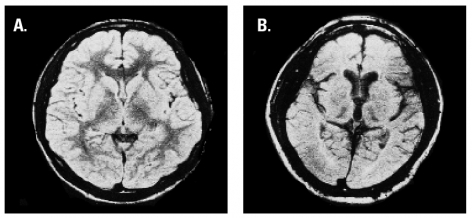What are the other medical consequences of inhalant abuse?
Inhalant abusers risk an array of other devastating medical consequences. The highly concentrated chemicals in solvents or aerosol sprays can induce irregular and rapid heart rhythms and lead to fatal heart failure within minutes of a session of prolonged sniffing. This syndrome, known as "sudden sniffing death," can result from a single session of inhalant use by an otherwise healthy young person. Sudden sniffing death is associated particularly with the abuse of butane, propane, and chemicals in aerosols. Inhalant abuse also can cause death by—
- asphyxiation — from repeated inhalations that lead to high concentrations of inhaled fumes, which displace available oxygen in the lungs;
- suffocation — from blocking air from entering the lungs when inhaling fumes from a plastic bag placed over the head;
- convulsions or seizures — from abnormal electrical discharges in the brain;
- coma — from the brain shutting down all but the most vital functions;
- choking — from inhalation of vomit after inhalant use; or
- fatal injury — from accidents, including motor vehicle fatalities, suffered while intoxicated.
Based on independent studies performed over a 10-year period in three different states, the number of inhalant-related fatalities in the United States is approximately 100–200 per year.
 Compared with the brain of an individual with no history of inhalant abuse (A), that of a chronic toluene abuser (B) is smaller and fills less of the space inside the skull (the white outer circle in each image). Courtesy of Neil Rosenberg, M.D., NIDA Research Report (NIH 05-3818).
Compared with the brain of an individual with no history of inhalant abuse (A), that of a chronic toluene abuser (B) is smaller and fills less of the space inside the skull (the white outer circle in each image). Courtesy of Neil Rosenberg, M.D., NIDA Research Report (NIH 05-3818).Animal and human research shows that most inhalants are extremely toxic. Perhaps the most significant toxic effect of chronic exposure to inhalants is widespread and long-lasting damage to the brain and other parts of the nervous system. For example, chronic abuse of volatile solvents, such as toluene or naphthalene (the volatile ingredient in mothballs), damages the protective sheath around certain nerve fibers in the brain and peripheral nervous system. This extensive destruction of nerve fibers is clinically similar to that seen with neurological diseases such as multiple sclerosis.
The neurotoxic effects of prolonged inhalant abuse include neurological syndromes that reflect damage to parts of the brain involved in controlling cognition, movement, vision, and hearing. Cognitive abnormalities can range from mild impairment to severe dementia.
Inhalants also are highly toxic to other organs. Chronic exposure can produce significant damage to the heart, lungs, liver, and kidneys. Although some inhalant-induced damage to the nervous and other organ systems may be at least partially reversible when inhalant abuse is stopped, many syndromes caused by repeated or prolonged abuse are irreversible.
Abuse of inhalants during pregnancy also may place infants and children at increased risk of developmental harm. Animal studies designed to simulate human patterns of inhalant abuse suggest that prenatal exposure to toluene can result in reduced birth weights, occasional skeletal abnormalities, delayed neurobehavioral development, and altered regulation of metabolism and body composition in males, as well as food intake and weight gain in both sexes. A number of case reports note abnormalities in newborns of mothers who chronically abuse solvents, and there is evidence of subsequent developmental impairment in some of these children. However, no well-controlled prospective study of the effects of prenatal exposure to inhalants in humans has been conducted, and it is not possible to link prenatal exposure to a particular chemical to a specific birth defect or developmental problem.
Finally, a 2008 survey of over 13,000 high school students has identified an association between disordered eating (defined as a positive response to one or more of three questions about engaging in inappropriate behaviors for weight control during the past 30 days) and inhalant use among both male and female students.
Hazards of Chemicals Found in Commonly Abused Inhalants
amyl nitrite, butyl nitrite
("poppers," "video head cleaner")
sudden sniffing death syndrome, suppressed immunologic function, injury to red blood cells (interfering with oxygen supply to vital tissues)
benzene
(found in gasoline)
bone marrow injury, impaired immunologic function, increased risk of leukemia, reproductive system toxicity
butane, propane
(found in lighter fluid, hair and paint sprays)
sudden sniffing death syndrome via cardiac effects, serious burn injuries (because of flammability)
freon
(used as a refrigerant and aerosol propellant)
sudden sniffing death syndrome, respiratory obstruction and death (from sudden cooling/cold injury to airways), liver damage
methylene chloride
(found in paint thinners and removers, degreasers)
reduction of oxygen-carrying capacity of blood, changes to the heart muscle and heartbeat
nitrous oxide ("laughing gas"), hexane
death from lack of oxygen to the brain, altered perception and motor coordination, loss of sensation, limb spasms, blackouts caused by blood pressure changes, depression of heart muscle functioning
toluene
(found in gasoline, paint thinners and removers, correction fluid)
brain damage (loss of brain tissue mass, impaired cognition, gait disturbance, loss of coordination, loss of equilibrium, limb spasms, hearing and vision loss), liver and kidney damage
trichloroethylene
(found in spot removers, degreasers)
sudden sniffing death syndrome, cirrhosis of the liver, reproductive complications, hearing and vision damage


